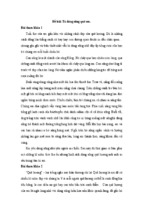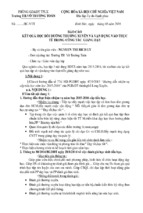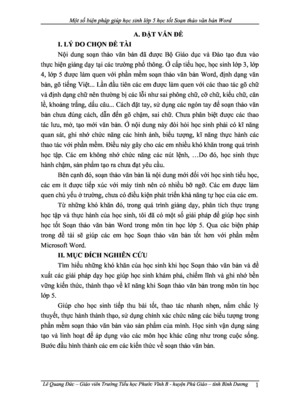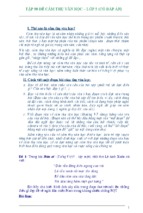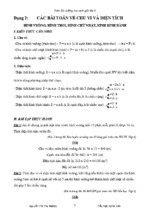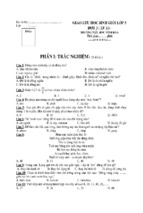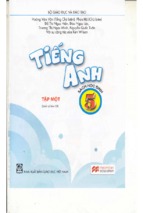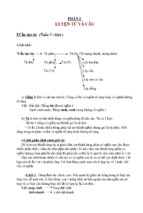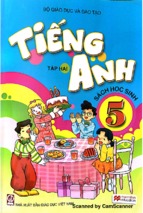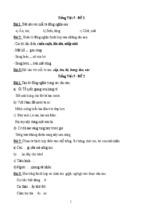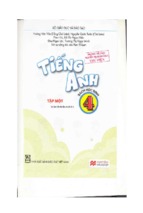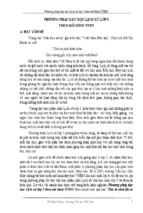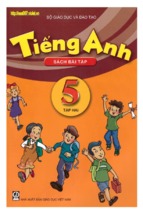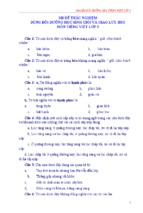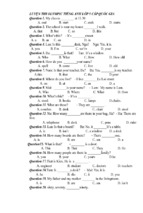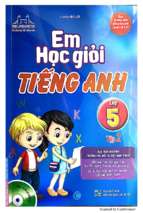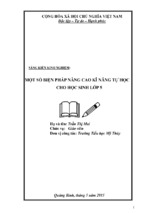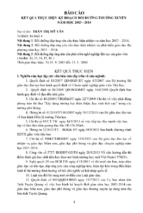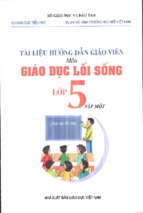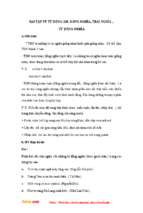BỘ GIÁO DỤC VÀ ĐÀO TẠO
Hoàng Văn Vân (Tổng Chủ biên) - Phan Hà (Chủ biên)
Nguyễn Quốc Tuấn - Đỗ Thị Ngọc Hiền - Nguyễn Song Hùng
Đào Ngọc Lộc - Trương Thị Ngọc Minh
Tập một
NHÀ XUẤT BẢN GIÁO DỤC VIỆT NAM
Sách được Hội đồng Anh hỗ trợ về chuyên môn
và các chuyên gia tư vấn tham gia đọc góp ý, thẩm định.
The publisher and authors are grateful for the special assistance of
the British Council in Viet Nam and, in particular, to the British EFL consultants for their invaluable
contribution to the development and completion of this primary English textbook series.
CONTENTS
Unit 1
A Summer Camp
24
Unit 2
My Friend’s House
35
Unit 3
A Birthday Party
44
Unit 4
Mai’s Day
53
Unit 5
Our Picnic to the Seaside
62
Review 1
Unit 6
A Visit to the Zoo
79
Unit 7
My Favourite Sports and Games
89
Unit 8
My Favourite Books
100
Unit 9
Our Teachers’ Day
110
Unit 10
How I Learn English
120
Review 2
3
INTRODUCTION
Tieng Anh 5 is the third of the three-level English coursebooks for Vietnamese
primary school pupils learning English as a foreign language (EFL). The book
follows a systematic, cyclical and theme-based syllabus approved by the Ministry
of Education and Training in August, 2010, which covers a thorough development
of skills but gives particular emphasis to listening and speaking at the early stages.
UNIT COMPONENTS
The whole Tieng Anh 5 - Student’s Book –
reflects the carefully sequenced
pedagogy of warm-up, presentation,
practice, and application to develop
English for basic levels and skills through
the twenty units and four reviews. The
twenty richly illustrated, cross-curricular
and theme-based units focus on offering
pupils motivation, memorable lessons
and a joyful learning experience of
English.
The characters in the Student’s Book are
built up from Tieng Anh 3 and Tieng Anh 4
creating a feeling of child-friendly and
familiar contact.
Clear lessons follow a logical progression
and include a wide range of activities
that help pupils develop interaction,
coordination, critical thinking, and
pre-language skills as they learn to
understand and use English in its spoken
and written forms.
Each unit contains three lessons which are
organized around a topic under one of the themes – Me and My Friends, Me and My School,
Me and My Family, and Me and the World Around – and offers pupils a sense of security
through predictable activities which are systematically sequenced from listening to
speaking, reading and writing. Each lesson provides materials for two periods (or eighty
minutes) of class contact.
Singing activities, total physical response (TPR), chants, and exciting games are included
to reinforce previously learnt English, motivate and support pupils in building their
confidence in communicating.
The following is a brief description of how a unit is organized and the purpose of each
part of the lesson.
4
LESSON 1
1. Look, listen and repeat.
The aim of this section is to present
some new language to pupils in a
context. After a warm-up activity,
Lesson 1 introduces pupils to the
new (target) language and vocabulary
through a series of dialogues. These
are usually connected to a particular
situation (context) which helps pupils
undertand the purposes for using
the new language and the meanings
of the dialogues. The context is created
through the attractive illustrations,
using child characters many of whom
pupils already know. The language is
presented in comic speech bubbles
to attract pupils’ interest.
The dialogues contain the new words
and structures which pupils are
expected to understand and use in
their communication. The teacher
can use a mixture of Vietnamese and
English, where necessary, when
helping pupils understand the
context for the dialogues.
2. Point, ask and answer.
The aim of this section is to practise the new vocabulary, structure(s) and competence(s)
introduced in Look, listen and repeat in different contexts. New vocabulary is introduced through
sentence and picture prompts for practice in communicative and controlled frameworks. Pupils
will produce this new language in the later activities such as listening, speaking, reading and
writing. With sufficient support and careful preparation from the teacher, the activity offers pupils
the feelings of security, achievement and confidence in interactive practice and using the new
language.
5
3. Listen and tick.
The aim of this section is to provide
listening practice embedding the new
language structures and vocabulary.
Listening is an important part of
communicating with others. Pupils
need to understand what someone says
so that they can respond appropriately.
This is why in Tieng Anh 5 we give a
lot of importance to listening. The
development of listening skills follows
the pattern established in Tieng Anh 3
and Tieng Anh 4 - a listening task in
Lesson 1 and another in Lesson 2.
The tasks are varied from Listen and
tick in most of the units to Listen and
circle or Listen and complete in later
units which require non-verbal
or verbal responses. In non-verbal
responses, pupils tick or circle one
of the prompted pictures which are
motivating and provide helpful
support for listening. In verbal responses
pupils read words/sentences and circle
the correct answers or fill incomplete
sentences with the correct prompts or
the information from the recording.
4. Talk.
The aim of this section is to provide practice for developing pupils’ speaking skills. Pupils are given
opportunities to practise using the learnt language in less controlled situations. For example, in
Unit 1, they will choose one of the foreign pupils in the pictures and introduce her/him to a
partner. In Units 7, 10, and in some of the later units, pupils ask each other about their favourite
sports, or dream house, or about their own village, using the new language they have learnt and
role play a given situation with their partners, and so on.
These activities create interest, allow some choice and possibility of extemporizing and personalizing
language and provide some options in using creatively the language they have learnt in oral
interaction.
6
LESSON 2
1. Listen and repeat.
The aim of this section is to
provide a useful tool for
pupils to practise English
spelling. Pupils are exposed
explicitly to an aspect of
English pronunciation via
the spelling. Troublesome
sounds to Vietnamese are
carefully selected to be
treated, usually two features
at a time (except Unit 6),
through words, dialogues
or chants. Phonics is a
useful tool for pupils to rely
on when they come across
new vocabulary in listening,
speaking, reading and
spelling, e.g. Unit 1
(Vietnamese, Indonesian),
Unit 2 (flat, block), Unit 6
(played, visited, watched), etc.
2 &3.
The activities in these sections require pupils to listen and respond in different ways such as
clapping, grouping, saying aloud, and completing the missing letters in the words provided.
7
4. Listen and number.
This section exposes pupils to a
listening activity for the second time.
Pupils number the pictures or events
according to the order in which they
hear from the recording.
The skill here is also listening for
details but this type of task is more
demanding than the earlier one in
Lesson 1, in most units from Unit 1 to
Unit 10, pupils listen to the recording
and then number the pictures. The
types of task are varied in later units
such as Listen and complete and Listen
and answer. The responses vary from
simple (one word) to more complex
(phrases) which are graded gradually:
from monologues to dialogues, and
within dialogues, from short
dialogues to long ones.
The activity is supported through
pictures or verbal contexts in the
Student’s Book and through the
teacher’s explanation.
5. Fun time
This section aims to provide more sources of spoken input including chants, poems, songs and
games to encourage pupils to participate in the use of English for entertainment.
Most Fun time activities in this section are games such as Bingo, information gap, funny story
or crossword puzzle to change the learning pace from previous activities. The responses are
varied, from non-verbal, e.g. In Bingo, TPR , information gap, matching, etc., to verbal, e.g. fun story,
guessing and flash card game. There are also crossword puzzles in 8 units, and they vary
in type from picture-clued base to word-clued base.
8
LESSON 3
1. Look, listen and repeat.
Like the Look, listen and repeat in Lesson 1, this section
aims to provide additional and contextualized language
input. The extra language is also presented in comic
format and is sequenced or linked to Lessons 1 and 2
with familiar characters but in new situations which
create contexts in which the language is used.
(Read more in the similar section in Lesson 1.)
2. Point, ask and answer.
This section is similar to the Point, ask and answer
section in Lesson 1. It aims to provide pupils with an
opportunity to practise, using the additional language
in the same way as they have done in Lesson 1. Pupils
use the new language structure and vocabulary
together with the language that they have learnt in a
variety of activities such as reading and writing as well
as speaking and listening.
(Read more in the similar section in Lesson 1.)
3. Read and do the tasks.
This section aims to provide a communicative and
purposeful context for pupils to practise reading. It
also helps to motivate pupils and to provide real
language use with a title and richly illustrated texts.
The reading tasks are read alone or combined
with a writing activity. They are designed to
develop pupils’ reading skills such as reading for
specific information, reading for gist, deciding on True
or False statements or Yes-No, sequencing, completing,
transferring, writing the answers to the questions and
referencing.
In many units, the follow-up oral tasks help pupils
apply the new content and language to speaking or
discussing in order to lead into writing. Pupils can
express their own experience in relation to the topic
via communicative interactions.
9
4. Write.
This section aims to develop
pupils’ writing skills.
Pupils practise writing to
reinforce their ability to
use the English that they
have acquired through oral
and aural activities in the
previous sections. Through
the writing tasks, pupils are
given opportunities to
make use of the vocabulary
and the sentence patterns
they have learnt to express
their ideas and experience
in relation to the topic of
the unit.
At this level, pupils
are required to write
simple sentences with
supports provided such
as a controlled writing
framework, useful
expressions, and guiding
questions.
5. Fun time
This section aims to make pupils learn English better through singing. Pupils enjoy songs
because they provide fun and bring about a different experience of language besides the formal
practice in Look, listen and repeat. Songs occur in 12 out of 20 units and are spread across the
textbook to change the pace from reading and writing activities. Most of the song lyrics are
adapted from the original ones to suit the language and the topic of the unit (Units 1, 3, 5, 9, etc.)
and the Vietnamese teaching and learning contexts.
10
NOTES ON TEACHING ENGLISH IN
PRIMARY CLASSES
The following notes aim to give support to the teacher and are not mandatory.
To suit the teaching and learning context of each school/province/region, the
teaching of every unit or lesson can be varied and the teaching steps can be
adapted. However, there are some key steps the teacher should keep in mind.
1. Preparation and timing (Lesson plan)
• It is important to go through the content(s) of the lesson and the teaching notes
before you go into the class. This will help you familiarize yourself with the materials
and know what materials to prepare for the lesson and what activities to conduct at
the lesson. You should look for the answer key for rather complicated activities such
as games and crossword puzzles before you teach.
• For some activities you should prepare some teaching materials which are not part
of the normal classroom materials such as an atlas for use in Unit 1, some felt-tip
coloured pens for Units 2, 3, 4, etc., family photos (Unit 4), postcards (Unit 5), animal
cut-outs from magazines (Unit 6), some students’ books (Unit 8), etc.
2. Warm-up
• You should do a warm-up activity at the beginning of every lesson. This is a short
activity (which is normally from two to five minutes) to draw pupils’ attention to the
use of English. This activity is a good way to revise the old lesson and to lead in the
new one. The warm-up activites can vary in some way to suit the teaching purpose,
for example, the teacher can get pupils to sing a known song or play a non-verbal
game such as Simon says, Flower game (hangman), Bingo, Slap the board, Doing
actions, Charades (guesssing game), etc.
3. Classroom management
• Pair work
It is advisable to get pupils to work in varied pairs as shown in the diagrams below.
In case the number of pupils is uneven, two pupils can share one role. Pupils should
change their partners regularly in order to change the working atmosphere.
The teacher can get a “closed pair” (two pupils sit next to each other) or an “open pair”
(two pupils sit apart from each other in the classroom) to model an activity as necessary.
11
• Group work
It is useful to divide pupils into groups of four or six or according to some criteria such
as: they are friends or those who have the same birthdays and hobbies. Separate pupils
who are disruptive.
Pair work
(varied)
Group work of 4 or 6
(varied)
• As pupils work in pairs or in groups, it is important to monitor the activity. Circulate
and offer help when necessary and remember not to interfere with pupils’ work or
correct all of their mistakes. Let them work independently and observe their ability to
use English as well as the problems or difficulties they encounter during the
activity to prepare for remedial work later.
• The activity should be timed and stopped before pupils lose interest or become
distracted. Class routines should be established for that such as putting hands up or
giving two claps to signal stopping the activity.
• Young learners do love praise. When pupils do well in front of the class or do a good
job, it is useful to praise them: Good, Very good, Great, Well done, Good job, etc. If a pupil
cannot do a task, it is advisable to encourage him/her: Try again or Have another try,
Not quite right, etc.
4. Classroom language
• English should be used as much as possible in instructions and classroom management.
This is a systematic approach to establish the interaction between the teacher and the
pupils and to reinforce the language the pupils have learnt. In order to help pupils
understand English, it is useful to accompany your English with some gestures,
movement, or even Vietnamese for the first times.
• The instructions should be simple, clear and consistent to help pupils feel secure and
know what they are required to do. If pupils are confused, Vietnamese should be used
to make them understand and to check their understanding to make sure that they
can perform the activities successfully.
• Classroom language can be considered as receptive language and productive
language. Pupils can understand and respond to the receptive classroom language,
and understand and use the productive classroom language in order to express what
they mean in interactions with the teacher or with other pupils.
• The following phrases are suggested instructions and expressions for use in
Tieng Anh 3, 4 and 5:
12
Receptive classroom language
Say it.
Answer this / the question.
Sit down, please,
Ask a question.
Spell it / the word(s).
Ask your neighbour /partner a question.
Stand up, please.
Check your answers in pairs / groups.
Talk to your partner.
Close your books.
Try again.
Copy it into your copybook / onto a piece /
onto a sheet of paper.
Well done / Excellent / That’s right / That’s not correct.
Correct / Not quite right / Wrong.
Work on your own.
Draw a picture of ...
Write a question.
Goodbye/Good night.
Write a sentence of your own.
Hello / Hi / Good morning / afternoon / evening.
Write the answer to this / the question.
Here it is / you are.
Write the answers to these / the questions.
How do you spell it in English?
I don’t think so.
Productive classroom language
Listen to Linda / this / the dialogue / story /
dialogue between Nam and Mai.
Already. / Not yet. / I’ve done it.
Can I borrow your pen/ pencil/rubber?
Listen.
I think it’s …
Look at this / the board / picture(s) / photo(s) /
puppet(s).
I understand / I don’t understand.
I’m sorry. I can’t remember.
Look.
I’m sorry. I don’t know.
Open your books.
Is this/that right?
Put up your hand.
It’s my / your go / turn.
Put your books away.
I’ve got one wrong / two right.
Quiet, please.
Me too.
Read this / the word(s) / dialogue aloud.
Please.
Repeat after me, please.
See you again / tomorrow / on Sunday / next week.
Repeat, please.
Thank you / Thanks / Many thanks.
Say it aloud.
What does it / this word / sentence mean?
Say it in English.
What’s … in English?
Say it in Vietnamese.
What’s number one / two / three / four?
5. How to end the lesson
• In order to establish the classroom routine, it is advisable to end the lesson in some
way to suit your teaching situations and the level of your pupils. If pupils stay in the
classroom for other classes, you can signal to end the lesson by putting hands up,
clapping hands or tapping the board and saying It’s time to stop, and getting pupils to
say Goodbye. See you the next time when you leave the room.
• If there is time, you can round off the lesson with a song/rhyme or a chant that pupils
have learnt during the unit.
13
TEACHING LANGUAGE SKILLS IN
TIENG ANH 5
1. TEACHING LISTENING
• Listening plays a very important part in early language learning. Through listening,
pupils become familiar with the sounds, rhythms and intonation of English. When
they listen, they use their natural instinct to understand and work out what the words
might mean. It is, therefore, important to present listening activities in a context in
which the purpose of the activity makes sense and in which the teacher provides
plenty of support for understanding such as using gestures, actions, pictures, puppets,
real objects, and even Vietnamese.
• Pupils can respond non-verbally in the early stages of listening with ticking/circling or
colouring/ drawing simple pictures or doing actions. In later stages, pupils can respond
verbally with reading and selecting or completing simple statements or giving answers
to particular questions.
• Here is a three-staged approach to teaching listening:
a. Before listening
• Focus pupils’ attention on the title of the unit or the task instruction and set up the
context or the purpose of the activity. Go through each dialogue or picture and the
target language or the word prompts. Elicit any words or ideas that pupils know
related to a particular situation, Do you understand the title of the unit? What can you
see in this picture? Who is this? What is it? Do you know it/him/her/them? What’s he/she
doing? What’s happening?, etc.
• Make sure pupils understand what the task is (Listen and repeat, Listen and tick /
match / circle / complete / number / answer, etc.) and what words or phrases to focus on
as they listen. Tell pupils that they do not need to understand every word to carry out
the activity.
• Pre-teach any words that pupils need to understand the listening text. Make use
of the pictures in the coursebook, flashcards, real objects (realia), puppets, posters,
gestures, movements or even Vietnamese. Then write the new words/phrases on the
board and have pupils repeat them a few times.
• Do the first example with pupils and check whether they know what to do and what
to listen for.
b. While listening
• Play the recording three times: once for pupils to listen to the whole text, once for
them to do the task, and once for them to check their answers. Leave enough time
between the listenings for pupils to do what they are required to.
• Monitor the activity and check whether pupils are doing the right thing. If they seem
confused, do the first example with them.
14
c. After listening
• Get pupils to show and compare their answers. It is advisable to ask individual pupils
to explain how they come to the answers (pupils can use Vietnamese to explain)
because they need to share their listening strategy with their classmates.
• If many pupils have got an item wrong, replay the recording and help them understand.
2. TEACHING SPEAKING
Like listening, speaking plays a very important part in early language learning. Pupils
can use their appropriate English to express what they mean in interactions with the
teacher or with their peers. Here is a three-staged approach to teaching speaking.
a. Before speaking
• Put the activity in context: focus pupils’ attention on the picture(s) or the dialogue(s)
(Look, listen and repeat; Point, ask and answer; Talk). Point to each picture and elicit
pupils’ answers to prediction questions such as What is this? Who’s this? Where is
he/she? What does this mean? When do you use it?, etc. or ask pupils to prompt the
words to complete the sentences in the speech bubbles or ask them to work in closed
pairs (read more in Class Management) or in groups.
• Use a variety of appropriate techniques which suit the level of the pupils to teach the
meaning of the new vocabulary. Encourage pupils to guess the meaning through
pictures and context.
b. While speaking
• Make sure pupils understand what the task is (Repeat, Point, Ask and answer, Talk, Sing,
Chant, Recite a poem, etc.).
• Play the recording or read the text twice (Look, listen and repeat): once for pupils to
listen all the way through and once for them to follow in their books. Check their
comprehension through gist questions.
• Get pupils to read the example(s) (Point, ask and answer) before they work in pairs or
groups.
• Model the example with the whole class or use an “open pair” or a “closed pair” for the
first time.
• Divide the class into groups/pairs, with each group/pair having a different role in the
dialogue/exchange. Play the recording or read the text. Each group/pupil says the
assigned character/line. Encourage pupils to perform actions as they speak.
• Repeat the step without the recording and encourage pupils to remember their lines.
• Move on to practise in pairs or in groups. Monitor the activity and offer help when
necessary. Focus on the pronunciation and, in particular, the stress and intonation
patterns.
c. After speaking
• Call groups/pairs to the front of the class to act out the dialogues or say the topic
required.
• Follow up the activity with freer activities based on the language of the current unit and
the earlier ones to provide pupils with good opportunities to communicate by relating
15
the language to their own situation, or create their own messages (Talk, Discussion,
Survey, Say the differences, Guess, Information gap, etc.). This also includes teacher
instructions and teacher-pupil interaction at the beginning or at the end of lessons.
Notes: The dialogues in each unit in Tieng Anh 5 contain both productive and receptive
English. Pupils are expected to learn and produce only the productive language and
to understand the receptive one. They do not need to remember and reproduce all the
words and structures in the unit. The productive speaking and listening are mostly in the
Point, Ask and answer, Talk, Role-play, Game(s), Chant(s), Poem(s), Song(s) sections and in
the interactions between the teacher and pupils and among pupils themselves.
3. TEACHING READING
The reading texts in Tieng Anh 5 are based on the familiar language materials that
have been orally/aurally practised, and the use of whole-word sign recognition as
well as phonics. In addition, the written words will support pupils’ understanding in
listening and speaking and make them feel more secure and get familiar with
conventions of print and text.
The procedure of teaching reading for specific information (reading for details) and
reading for gist (reading for general idea) in class can be staged into before, while and
after reading.
a. Before reading
• Set up the context and prepare a motivating and interesting atmosphere. Elicit pupils’
responses to questions about the title and the pictures in their books. Encourage
pupils to guess what the text is about before they start their reading.
• Encourage pupils to work out the meaning of new words through contexts or relate
their clues together to understand the meaning of the text. Pre-teach the key words
that pupils cannot guess, using pictures, gestures, antonyms, synonyms and even
Vietnamese for abstract notions. Write the key words on the board and get pupils to
repeat them a few times.
• Make sure pupils understand the tasks before they start reading. Encourage pupils to
work independently.
b. While reading
• It is advisable to establish a classroom routine in the earlier lessons in which pupils put
up their hand in case they need the teacher’s support as they do the reading tasks.
• Tell pupils not to worry if they cannot understand every single word because that
does not prevent them from doing the tasks. Ask some simple questions to check if
they understand the general point of the text (reading for gist) and the details
(reading for specific information).
• Give pupils sufficient time to read the text and let them work in silence. Monitor the
activity and offer help as necessary.
• Get pupils to check their answers in pairs or in groups. In case pupils in a pair or a
group disagree with each other on any answer, tell them to read the instructions and
the text again.
16
c. After reading
• Check the answers with the whole class. Ask some individual pupils how they come to
the answers. They can explain in Vietnamese.
• Get some pupils to write the answers on the board if time is available.
• Conduct an oral practice of questions and answers without looking at the lines in
their books.
• Do any follow-up activity/extension suggested in the Teacher’s Book.
4. TEACHING WRITING
In Tieng Anh 5, initial writing emphasis is on supporting and reinforcing oral-aural work,
particularly the spelling of familiar vocabulary and sentence patterns. The writing
tasks often follow a model text or relate what the pupils have read to their personal
experience, interests and hobbies. Pupils love to see their work displayed and read by
their peers and the teacher.
a. Before writing
• Set the context or the purpose of writing: elicit pupils’ answers to the questions related
to the writing content. Be sure that pupils know what they are going to write. In case
they have no idea, get them to read the reading passage or the model text carefully in
order to piece together the ideas that they need for their writing task.
• Elicit pupils’ answers to check their comprehension of the related language. Write on
the board the key words or structures necessary for pupils to do the task. For some
tasks, pupils have to discuss in pairs or in groups before they work individually.
• Get pupils to be aware of spelling, punctuation and capitalization.
b. While writing
• It is useful to suggest that pupils should write their draft before they copy their work
onto a neat and clean sheet of paper because good pieces of writing will be used for
class display later.
• Pupils work individually. Monitor the activity and help pupils correct any mistakes.
c. After writing
• Get pupils to exchange their work in pairs. Ask a few individual pupils to read their
work to the class.
• Have a classroom display, make use of the board or the space in a corner of the classroom.
5. TEACHING VOCABULARY
Teaching vocabulary helps pupils understand, memorise and use the words/phrases
appropriately in specific contexts. Young pupils learn English words and chunks (words/
phrases) that combine vocabulary and grammatical patterns in an unanalysed way.
Therefore, it is crucial to give pupils plenty of time to practise, memorise, recycle, and
extend their vocabulary and grammar in meaningful contexts. Teach the form of the
word (sound and spelling) as well as its meaning and other related aspects of words
such as grammatical changes in forms and collocations (words that go together).
• Use a picture/ puppet/real object/a flashcard/gestures or even Vietnamese (for abstract
meaning) to help pupils recognise the meaning of the word/phrase.
• Say/Play the recording for pupils to listen and repeat the word/phrase a few times.
• Get pupils to practise using the word in a wide range of spoken or written activities in
pairs or in groups.
17
6. TEACHING PRONUNCIATION
In Tieng Anh 5, the pronunciation activities relate the language introduced in the unit
to the language in the earlier ones. They vary in types: phonics, songs, rhymes, chants,
and games.
a. Phonics
Phonics enables pupils to recognise the relationship between letters or letter
combinations and the sounds they make, e.g. blue, flat (Unit 2), watched, visited,
played (Unit 6), etc. With the knowledge of phonics, pupils are able to improve their
speaking and reading skills because they can identify the spelling and the
pronunciation patterns of the text they hear and decode them quickly.
• Draw pupils’ attention to the letter(s) and its/their sound(s) in words, and model the
new sound(s) a few times for pupils to repeat.
• Elicit pupils’ answers to check their comprehension of the dialogues/chants/poems.
Show them how to respond as they listen to the recording (e.g. to repeat or to do
actions). Play the recording or read the text twice: once for pupils to listen to the text all
the way through, and once for them to clap the focused sounds or to repeat each line.
• Divide the class into groups to say different lines or roles in the dialogues with or
without the recording.
• Make sure pupils understand the follow-up activities before they do them.
• Call on some individual pupils to report the answers orally or write on the board.
• Get the class to read together the answers.
b. Songs/rhymes/chants
Songs/rhymes/chants aim to provide additional resources that help pupils listen to
natural English and speak it fluently.
• It is advisable to set the context and teach new vocabulary, using flashcards, realia,
pictures, etc; and mime the lines if possible.
• Elicit pupils’ answers to check their comprehension of the text.
• Play the recording a few times for pupils to repeat each line of the song/rhyme/chant
with or without their books opened.
• Divide the class into groups to practise the song/rhyme/chant(s)/poem(s). Pupils
should tap their hands on the desk or stamp their feet to keep the rhythm.
• Get a few groups to perform the task in front of the class with actions.
• It is advisable to incorporate songs/rhymes/chants into each lesson. Use them to
warm up or round up a lesson to motivate pupils.
c. Other activities
Spelling and writing
• Give a list of the words in focus that you want the pupils to spell correctly. Select some
pupils to read the words aloud. Individually, pupils look at each word, say it, and write
it down into their notebooks. Pupils check their work in pairs or groups.
• Write the focused words on the board. Assign one word to each pupil to copy it onto
a small piece of paper. Collect the pieces of paper and mix them up. Put them into a
box. Have two teams take turns to pick out a word and say it to their opponent team
member. This pupil must spell the word correctly to score a point.
18
Dictation
Pupils work in pairs or in groups. They take turns to dictate the focused words to each
other and check each other’s spelling. Another way is that the teacher dictates and all
pupils listen and write the dictation. Then pupils work in pairs to correct their products.
Word cards
Prepare word cards for the focused words you wish to check. Involve two teams of
four pupils in the activity. Pupils from each team take turns to come to the front of the
class to pick a card. They act out the word on the card for their team, who has to guess
the word, up to five tries, to score a point.
TPR (Total Physical Response)
TPR are actions done as commanded to associate the language with the movement to
provide pupils with a strong support to understand the language. It provides a physical
and fun context for the successful understanding of the key language, without the
need to produce accurate English at an early stage of learning. The procedure of using
TPR as a teaching technique is as follows:
• Play the recording or say the text. Do the actions associated with the text. Repeat the
step. Play the recording again without actions.
• Ask pupils to share ideas within a group to see how much of the text they can remember.
• Get pupils to say the text again without actions.
Games
Bingo
Draw a word grid on the board and ask pupils to copy it. Pupils tell you the words they
have studied in their lessons. List them on the board. Pupils choose the words from
the list to copy into their grid. While they are doing this, copy each word onto a strip
of paper, put the strips of paper into a bag and mix them up. Select pupils to pick out
a strip of paper and to call out the word. Pupils with that word in their grid put a cross
on it. Continue the game until there is a pupil who has all the words on a straight line
crossed out.
Charades (Miming)
This is a great game to review vocabulary. You may need to do the actions with pupils
if they are shy at first. This will help them to feel more comfortable and secure. Divide
the class into two teams. Show the first team a vocabulary word. They must act it out.
If the second team can guess the correct word, they get a point. Switch the teams and
let the second team act out a word while the first team guesses.
Simon says …
This is a fun and classic game. The teacher (or a pupil) tells pupils to carry out actions by
saying: “Simon says ... touch your nose/stamp your feet”, etc. If the teacher does not say
“Simon says…” the pupils should do nothing. Have pupils write four or five commands
they have learnt on a sheet of paper (e.g. stand up, sit down, clap your hands, stamp your
feet, touch your ears, etc.). Explain the rules of the game and make sure pupils
understand that they must hear “Simon says...” to perform the action. If not, they do
nothing. You can play a trial game until pupils have understood. Pupils should use the
commands they have written down. Pupils are eliminated if they do not perform the
correct action, or if they perform an action when they do not hear “Simon says...”.
Kim’s game
This is a memory game. Collect together a group of items in the same semantic field,
e.g. school things or pictures of things in a room. The pupils should be familiar with
19
the vocabulary. Arrange the items on a desk and cover them with a piece of cloth. Do
not let pupils see what is beneath the piece of cloth. Have a brief discussion with the
class on what might be under the piece of cloth based on the shape and size of what
they can see, etc.
• Divide the class into groups. Do not allow any pupil to write anything down. Explain
that you will show the class the things under the piece of cloth for 60 seconds in
silence. After that, each group must write down the name of as many objects as they
can remember.
• Show the items for 60 seconds then cover them with the piece of cloth. Back in their
groups, the pupils try to remember what they have just seen. Groups can get a point
for a correct guess and another for a correct spelling and so on. The group with the
most points wins the game.
Find your partner
• Write on the board the sentences in focus in the unit, e.g. I broke my leg. I got a scratch
on my face. I spilled hot water on my feet, etc. Divide the class onto groups. Each pupil
in half of the group selects and copies a sentence onto a strip of paper and keeps it
secret. Each pupil in the other half keeps a picture card containing the corresponding
accident.
• The teacher sets the time and says Go! Pupils move and ask the question What
happened to you? to search for the pupil who has the correct picture.
S1 (has the sentence I broke my leg.): What happened to you?
S2: I’ve got a bad cut.
S1: Sorry. Wrong person.
S1 goes on asking until he/she finds the right pupil and says You are my partner!
The two pupils slap their hands and stand side by side until the rest of the group
finds their partners. The group that finishes the activity first wins the game. Beware of
cheating!
Find someone who …
This is an alternative game of Find your partner. For example, use the picture cards
of the locations of a dream house which is near the seaside/on a mountain/in the
country/in the city/in town/by a lake/by a river, etc., to search for someone who wants
to have a dream house in the right location. The idea of this game is the same as in
the “Find your partner” game.
S1 (has the picture of a dream house): Where will your dream house be?
S2: It will be on a mountain.
S1: What will it be like?
S2: It will be a big house…
S1 moves and asks until he/she finds the right pupil who wants his/her house.
Weather sentences (sentence making)
• This is a card game. There are sets of weather cards, days (today or tomorrow) and
temperature cards for H (hot), C (cold), W (warm), Co (cool).
• Pupils play in pairs. Pupil A selects and arranges one weather card, one day card and
one temperature card on the desk, e.g. one sunny card, one day card, (today) and one
20
- Xem thêm -

